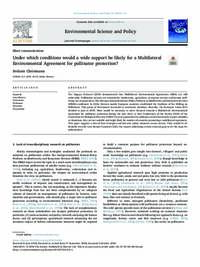Under which conditions would a wide support be likely for a Multilateral Environmental Agreement for pollinator protection?

Authors:
The Nagoya Protocol (2010) demonstrated that Multilateral Environmental Agreements (MEA) are still achievable. Pollination services are essential for biodiversity, agriculture, ecosystem services and human well-being, but in jeopardy as The Intergovernmental Science-Policy Platform on Biodiversity and Ecosystem Services (IPBES) confirmed. In 2016, thirteen mostly European countries established the Coalition of the Willing on Pollinators. This group of forerunners increased to twenty-one members. Recently, the European Union (EU) decided to join in 2018. What would be necessary to move forward towards a Multilateral Environmental Agreement for pollinator protection during the next three or four Conferences of the Parties (COP) of the Convention for Biological Diversity (CBD)? Current approaches for pollinator protection mostly require subsidies or donations, they are not scalable and might limit the number of countries promoting a multilateral agreement.This paper suggests a mix of four strategies and low-cost policy measures across sectors. They would be affordable even for Low Income Countries (LIC), but require addressing certain research gaps to set the stage for policymakers.
